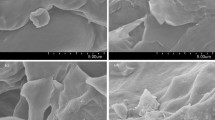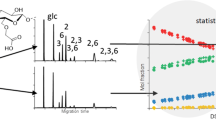Abstract
The protonation behavior of 6-deoxy-6-(2-aminoethyl)amino cellulose as a novel soluble aminated derivate of cellulose was studied by means of the potentiometric titration technique. The resulting proton binding isotherms exhibit two equivalent steps, which can be described by the standard macroscopic two-pK model, in which the degree of protonation is averaged over all the amine groups. In addition, a microscopic proton binding model was applied, in which the protonation sites are distinguished and the protonation free energy is expanded into an intrinsic term and an electrostatic repulsion between the primary and secondary amine groups. The protonation behavior of 6-deoxy-6-(2-aminoethyl)amino cellulose was compared with a model compound (N-methylethylenediamine).




Similar content being viewed by others
References
Aksberg R, Ödberg L (1990) Adsorption of an anionic polyacrylamide on cellulosic fibers with pre-adsorbed cationic polyelectrolytes. Nord Pulp and Paper Res J 411990:168–171
Avci D, Nuri M, Dagusan L (2002) New cationic polyelectrolytes for flocculation processes of baker’s yeast waste water. Polym Bull 48(4–5):353–359
Baumann H, Keller B, Ruzicka E (1991) Partially cationized cellulose for non-thrombogenic membrane in the presence of heparin and endothelial-cell-surface-heparansulfate (ES-HS). J Membrane Sci 61:253–268
Berger J, Reist M, Mayer JM, Felt O, Peppas NA, Gurny R (2004) Structure and interactions in covalently and ionically crosslinked chitosan hydrogels for biomedical applications. Eur J Pharm Biopharm 57:19–34
Berlin P, Klemm D, Jung A, Liebegott H, Rieseler R, Tiller J (2003) Film-forming aminocellulose derivatives as enzyme-compatible support matrices for biosensor developments. Cellulose 10:343–367
Berscht PC, Nies B, Liebendorfer A, Kreuter J (1994) Incorporation of basic fibroblast growth factor into methylpyrrolidinone chitosan fleeces and determination of the in vitro release characteristics. Biomaterials 15:593–600
Borkovec M, Koper GJM (1994) Ising models of polyprotic acids and bases. J Phys Chem 98:6038–6045
Borkovec M, Jönsson B, Koper GJM (2001) Ionization processes and proton binding in polyprotic systems: small molecules, proteins, interfaces and polyelectrolytes. In: Matijević E (ed) Prog Coll Pol Sci 16:99–339
Borkovec M, Koper GJM, Piguet C (2006) Ion binding to polyelectrolytes. Curr Opin Colloid Interface Sci 11(5):280–289
Čakara D, Fras L, Bračič M, Stana Kleinschek K (2009) Protonation behaviour of cotton fabric with irreversibly adsorbed chitosan: a potentiometric titration study. Carbohyd Polym 78:36–40
Culler MD, Bitman J, Thompson MJ, Robbins WE, Dutky SR (1979) Mastitis: I. In vitro antimicrobial activity of alkyl amines against mastitic bacteria. J Dairy Sci 62:584–595
Czaja W, Krystynowicz A, Bielecki Sand Brown RM (2006) Microbial cellulose. The natural power to heal wounds. Biomaterials 27(2):145–151
Dobrynin AV, Rubinstein M (1999) Hydrophobic polyelectrolytes. Macromolecules 32(3):915–922
Dobrynin AV, Rubinstein M (2005) Theory of polyelectrolytes in solutions and at surfaces. Prog Poly Sci 30(11):1049–1118
Dumitriu S (2002) Polymeric biomaterials, 2nd edn (revised and expanded). Marcel Dekker, Inc., New York, pp 1–213
Gärdlund L, Norgren M, Wägberg L, Marklund A (2007) The use of polyelectrolyte complexes (PEC) as strength additives for different pulps used for production of fine paper. Nord Pulp Paper Res 22(2):210–216
Goyal S, Dhull SK, Kapoor KK (2005) Chemical and biological changes during composting of different organic wastes and assessment of composting maturity. Bioresour Technol 96:1584–1591
Hashem A, Shishtawy RME (2001) Preparation and characterization of cationized cellulose for the removal of anionic dyes. Adsorpt Sci Technol 19:197–210
Hattori K, Yoshida T, Nakashima H, Premanathan M, Aragaki R, Mimura T, Kaneko Y, Yamamo N, Uryu T (1998) Synthesis of sulfonated amino polysaccharides having anti-HIV and blood anticoagulant activities. Carbohyd Res 312:1–8
Hebeish A, Hashem M, EL-Hosamy M, Abass S (2006) Cationization of linen fabric: studying the process parameters. RJTA 10(1):73–88
Hoenich N (2006) Cellulose for medical applications: past, present, and future. BioResources 1(2):270–280
Holm C, Joanny JF, Kremer K, Netz RR, Reineker P, Seidel C, Vilgis TA, Winkler RG (2004) Polyelectrolyte theory. In: Polyelectrolytes with defined molecular architecture II, vol 166. Springer, Berlin, pp 67–111
Jung A, Berlin P (2005) New water-soluble and film-forming aminocellulose tosylates as enzyme support matrices with Cu2+-chelating properties. Cellulose 12:67–84
Kaputskii FN, Gert EV, Torgashov VI, Zubets OV (2005) Hydrogels for medical applications fabricated by oxidative-hydrolytic modification of cellulose. Fibre Chem 37:485–489
Katchalsky A, Mazur J, Spitnik P (1957) Section II: polybase properties of polyvinylamine. J Polym Sci 23(104):513–532
Koper GJM, van Genderen MHP, Elissen Roman C, Baars M, Meijer EW, Borkovec M (1997) Protonation mechanism of poly(propylene imine) dendrimers and some associated oligo amines. J Am Chem Soc 119(28):6512–6521
Koper GJM, van Duijvenbode RC, Stam D, Steuerle U, Borkovec A (2003) Synthesis and protonation behavior of comblike poly(ethyleneimine). Macromolecules 36(7):2500–2507
Li H, Du Y, Xu Y (2004) Adsorption and complexation of chitosan wet-end additives in papermaking systems. J Appl Polym Sci 91:2642–2648
Liesene J (2009) Synthesis of water-soluble cationic cellulose derivatives with tertiary amino groups. Cellulose 17:167–172
Lim SH, Hudson SM (2004) Synthesis and antimicrobial activity of a water-soluble chitosan derivative with a fiber-reactive group. Carbohyd Res 339(2):313–319
Manning GS (1981) Limiting laws and counterion condensation in polyelectrolyte solutions. 6. Theory of the titration curve. J Phys Chem US 85(7):870–877
Marcus RA (1954) Titration of polyelectrolytes at higher ionic strengths. J Phys Chem US 58(8):621–623
Mesquita JP, Donnici LC, Pereira FV (2010) Biobased nanocomposites from layer by-layer assembly of cellulose nanowhiskers with chitosan. Biomacromolecules 11:473–480
Montplaisir D, Daneault C, Chabot B (2008) Surface composition of grafted thermomechanical pulp through XPS measurements. BioResources 3(4):1118–1129
Muzzarelli RAA (2009) Chitins and chitosan for the repair of wound skin, nerve, cartilage and bone. Carbohyd Polym 76:167–182
Muzzarelli RAA, Mattioli-Belmonte M, Tietz C, Biagini R, Ferioli G, Brunelli MA, Fini M, Giardino R, Ilari P, Biagini G (1994) Stimulatory effect on bone formation exerted by a modified chitosan. Biomaterials 15:1075–1081
Myllytie P, Salmi J, Laine J (2009) The influence of pH on the adsorption and interaction of chitosan with cellulose. BioResources 4(4):1647–1662
Packham RF (2007) The laboratory evaluation of polyelectrolyte flocculants. Brit Polym J 4(4):305–315
Pecse A, Jordane AA, Carluci G, Cintio A (2005) Articles comprising caionic polysaccharides and acidic pH buffering means. US Patent Application Publication:0124799 A1
Ravi Kumar MNV (2000) A review of chitin and chitosan applications. React Funct Polym 46:1–27
Rodríguez R, Alvarez-Lorenzo C, Concheiro A (2003) A Cationic cellulose hydrogels: kinetics of the cross-linking process and characterization as pH-/ion-sensitive drug delivery systems. J Control Release 86(2–3):253–265
Smith RM, Martell AE (1989) Critical stability constants, vol 6. Plenum Press, New York
Swerin A, Wägberg L (1994) Size exclusion chromatography for characterisation of cationic polyelectrolytes used in papermaking. Nordic Pulp Paper Res J 411994:18–26
Swerin A, Odberg L, Lindström T (1990) Deswelling of hardwood kraft pulp fibres by cationic polymers. Nordic Pulp Paper Res J 411990:188–196
Szakacs Z, Kraszni M, Noszal B (2004) Determination of microscopic acid–base parameters from NMR-pH titrations. Anal Bioanal Chem 378(6):1428–1448
Ulrich S, Laguecir A, Stoll S (2005) Titration of hydrophobic polyelectrolytes using Monte Carlo simulations. J Chem Phys 122(9):094911–094919
Van Duijvenbode RC, Rajanayagam A, Koper GJM, Borkovec M, Paulus W, Steuerle U, Haussling L (1999) Influence of the distance between ionizable groups on the protonation behavior of various hexaamines. Phys Chem Chem Phys 1(24):5649–5652
Wu M, Kuga S (2006) Cationization of cellulose fabrics by polyallyamine binding. J Appl Polym Sci 100:1668–1672
Yang S, Fu S, Li X, Zhore Y, Zhan H (2010) Preparation of salt-sensitive and antibacterial hydrogel based on quaternized cellulose. BioResources 5(2):1114–1125
Acknowledgments
We thank Matej Bracic (Laboratory for Characterisation and processing of Polymers) for his skilful technical assistance. We thank the Eureka office (project E4952—Biopackaging) which provided financial support for this work. The authors also thank to Prof. Per Stenius for valuable discussions during the preparation of manuscript.
Author information
Authors and Affiliations
Corresponding author
Additional information
Lidija Fras Zemljič and Duško Čakara have equally contributed to the manuscript.
Lidija Fras Zemljič—Member of the European Polysaccharide Network of Excellence (EPNOE).
Appendix: Protonation equilibria for diprotic molecules
Appendix: Protonation equilibria for diprotic molecules
The macroscopic proton binding isotherms
For a diprotic molecule, the two deprotonation steps are:
where the K i denote the step-wise mixed dissociation constants. Please note that K i are indexed according to the protons bound to the protonated species, thus the protonation (not deprotonation) step. For a base n = +2, while for an acid n = 0. The cumulative deprotonation reactions and the respective cumulative constants are defined as
The macroscopic protonation state is determined by the number of protons bound to the molecule. The total concentration of the molecule, [H2A]0 is the sum of all the protonation species
At a given pH = −loga +H , and provided [H2A]0 is known, Eqs. 6–8 or alternatively 4, 5, and 8 form closed sets, which permits calculating the probabilities of the three protonation species P 0 = [An−2]/[H2A]0, P 1 = [HAn−1]/[H2A]0 and P 2 = [H2An]/[H2A]0 from the dissociation constants. The overall degree of protonation is obtained as
The discrete site binding model
Distinguishing the protonation sites leads to the microscopic protonation scheme for a diprotic molecule (Borkovec and Koper 1994; Borkovec et al. 2001; Szakacs et al. 2004) (Fig. 5)
In this picture, the particular sites are indexed and a microscopic protonation state (microstate) is defined by a set of the state variables {s i }, where s i = 0 for deprotonated and s i = 1 for protonated. For a diprotic molecule, the index i can attain values of 1 or 2.
A microscopic dissociation constant (microconstant) \( \hat{K}_{k} \left\{ {s_{i} |k} \right\} \) can be attributed to each site k and microstate {si≠k}. For modelling purposes, particularly useful are the microconstants for the first protonation step denoted as \( \hat{K}_{k} \)
In this step, a proton is bound at the site k of the fully deprotonated molecule. The site binding model equivalent to the Ising model, is defined by expanding the protonation free energy of a microstate F({s i }) as (Borkovec and Koper 1994)
where ε i,j is the electrostatic interaction parameter between the protonated sites i and j, and neglecting the higher-order terms. NB this notation is valid only if the protonated site has the charge number +1, thus in the case of bases. ε i,j is related to the free energy of the electrostatic repulsion as
For a diprotic molecule, Eq. 11 simplifies to
In this case, the two macroscopic cumulative constants defined in Eqs. 6 and 7 can be written as
For the purpose of the present work, the EDA functionality and the N-methylethylenediamine were modelled with the same \( \hat{K}_{i} \) value for both protonation sites, in which case the above two equations simplify to
Thus, for a diprotic molecule, one can calculate the macroscopic degree of protonation from the microscopic protonation constant \( \hat{K} \) and the electrostatic interaction parameter ε by combining Eqs. 6–8 and 16, 17. A full derivation of the above relations and a comprehensive description of the above model for the present, as well as much more complex cases of polyelectrolytes and surfaces can be found in the afore mentioned papers.
Rights and permissions
About this article
Cite this article
Zemljič, L.F., Čakara, D., Michaelis, N. et al. Protonation behavior of 6-deoxy-6-(2-aminoethyl)amino cellulose: a potentiometric titration study. Cellulose 18, 33–43 (2011). https://doi.org/10.1007/s10570-010-9467-x
Received:
Accepted:
Published:
Issue Date:
DOI: https://doi.org/10.1007/s10570-010-9467-x





